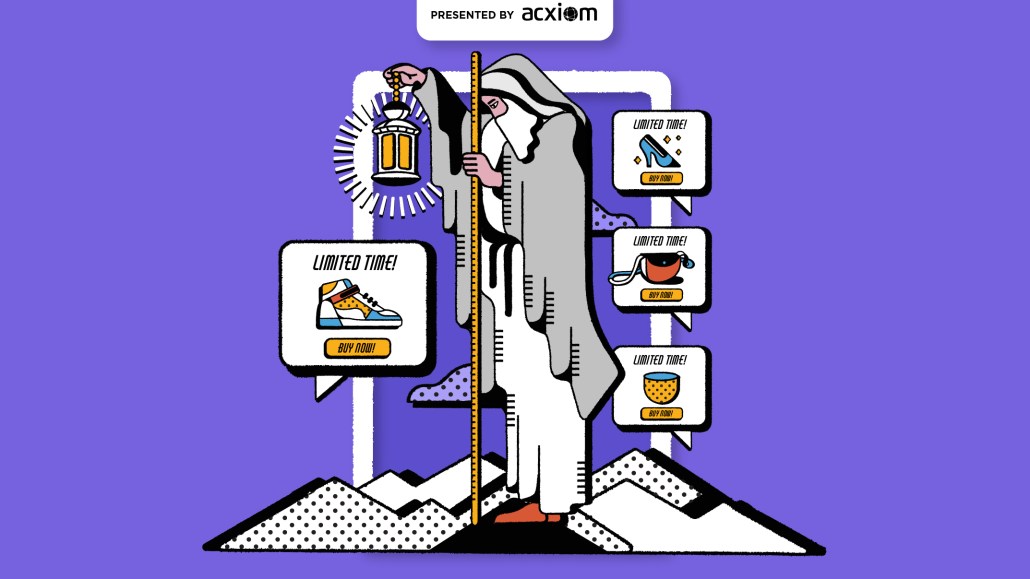Save 50% on a 3-month Digiday+ membership. Ends Dec 5.
Brands search for retargeting alternatives as third-party cookie demise looms

This article is part of the Digiday Privacy Preview, a digital issue of stories examining what the coming changes to Chrome and iOS will do to the worlds of media and marketing. Read the rest of that coverage here.
Last year’s precipitous drop in brick-and-mortar retail sales left brands relying more than ever on digital advertising and retargeting to acquire customers. But the invasiveness of retargeting has long put consumers in a conspiratorial mood (“How the hell does my phone know I need to buy toilet paper?”).
Now, the big platforms like Apple and Google as well as browsers like Firefox are all blocking or planning to block third-party cookies, the primary method that brands use to retarget customers. Those changes, coupled with cookie-curtailing legislation like Europe’s GDPR, mean third-party retargeting is about to get much more difficult.
That leaves brands that rely on retargeting in a bind. Without the traditional source of third-party data, brands will have to rely on alternatives like first-party data or data from retail partners. There’s also hope that Google’s alternatives to cookies will help pick up the slack, but there aren’t many details yet on how well those options will work. Right now, everyone is just trying to get their bearings, buyers told Digiday.
“Many brands are in the education phase, learning what it means to really build a privacy-first approach to marketing, and what is going to break when these new updates hit,” said Shelley Pinsonneault, vp of verified global technology at Publicis Media.
Brands can retarget using identifiers other than cookies, but doing so might require an upheaval to how that brand’s marketing apparatus is set up, said Carina Pologruto, chief information officer at Marketsmith.
“Retargeting is alive and well, but must now be driven from [a] different technology,” Pologruto said. “Rather than using a cookie, retargeting will require either a unique ID or device ID mapping in order to serve up the retargeted ad. Brands should evaluate their current retargeting efforts — are you using a DSP that provides device-level retargeting of an identity graph? If so, you should be in good shape. If not, it may be time to look at your retargeting mix between display and social.”
Ad position: web_incontent_pos1
Google has announced it won’t build any alternative identifiers or build user-level profiles within its system. Instead, it has hyped a technology called Federated Learning of Cohorts, or FLoC, which will place users of certain habits into “cohorts” that brands can target instead of individual users. Google claims FLoC gets brands 95% of the return on investment as retargeting through cookies, it hasn’t revealed how it got that number and some brands are skeptical.
Aaron Luo, founder and CEO of luxury bag brand Caraa, said he isn’t overly concerned about the difference between cookies and FLoC because he’s pivoted his brand to focus on first-party data collection. Since the pandemic began, Caraa has collected hundreds of new email addresses by refocusing the marketing team’s priorities. The trade-off of first-party data — that it’s harder to come by and is not as scalable — is worth it for the higher quality both Luo and buyers said.
“Marketers will have less scale [with first-party data], but much more impact,” said Shane McAndrew, chief data strategy officer, U.S., at Mindshare. “We gain more than we lose. First- party data is permissioned, of an incredibly high fidelity as it’s straight from the consumer, and therefore much more impactful in measuring business drivers and impact than third party data.”
There’s also data from partners. In the wake of third-party cookies waning, retailers like Target and Walmart have pitched themselves as data providers to brands, as well as places to sell products. A Target pitch deck from last year highlighted the data Target collects on customers and pitched access to its media platform Roundel as a selling point for data-hungry brands.
(This also has the added benefit for retailers of luring back brands who have switched to a direct-to-consumer model in the last few years.)
Ad position: web_incontent_pos2
“We expect to see brands start testing into tactics like commerce via retail media networks, variations of contextual, and buying against identity-based solutions, both ID and cohort-based solutions,” said Pinsonneault. “You may also see brands leaning in heavily to this concept of second-party data marketplaces in hopes of being able to access and join more high-value data with their own first-party data.”
Finally, some brands like Caraa are simply counting on the fact that some alternative to the third-party cookie will present itself.
“I can’t speak for their strategy, but Google’s revenue comes from advertising and they wouldn’t remove this option if they didn’t have an alternative lined up,” Luo said.
More in Media

Digiday+ Research Subscription Index 2025: Subscription strategies from Bloomberg, The New York Times, Vox and others
Digiday’s third annual Subscription Index examines and measures publishers’ subscription strategies to identify common approaches and key tactics among Bloomberg, The New York Times, Vox and others.

From lawsuits to lobbying: How publishers are fighting AI
We may be closing out 2025, but publishers aren’t retreating from the battle of AI search — some are escalating it, and they expect the fight to stretch deep into 2026.

Media Briefing: Publishers turn to vertical video to compete with creators and grow ad revenue in 2026
Publishers add vertical video feeds to their sites to boost engagement, attract video ad spend and compete with news creators.
Ad position: web_bfu





